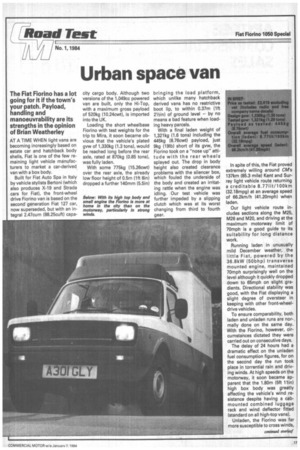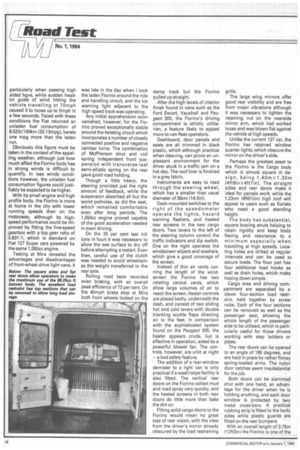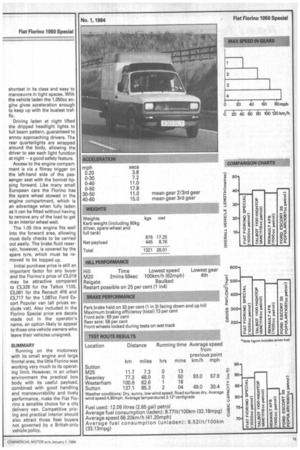Urban space van
Page 21

Page 22

Page 23

If you've noticed an error in this article please click here to report it so we can fix it.
The Fiat Fiorino has a lot going for it if the town's your patch. Payload, handling and manoeuvrability are its strengths in the opinion of Brian Weatherley
AT A TIME WHEN light vans are becoming increasingly based on estate car and hatchback body shells, Fiat is one of the few remaining light vehicle manufacturers to market a car-derived van with a box body.
Built for Fiat Auto Spa in Italy by vehicle stylists Bertoni (which also produces X-19 and Strada cars for Fiat), the front-wheel drive Fiorino van is based on the second generation Fiat 127 car, now superseded, but with an integral 2.47cum (88.25cuft) capa city cargo body. Although two versions of the 1,049cc powered van are built, only the Hi-Top, with a maximum gross payload of 520kg (10.24cwt), is imported into the UK.
Loading the short wheelbase Fiorino with test weights for the trip to Mira, it soon became obvious that the vehicle's plated gvw of 1,330kg (1.3 tons), would be reached long before the rear axle, rated at 870kg (0.85 tons), was fully laden.
With some 775kg (15.26cwt) over the rear axle, the already low floor height of 0.5m (lft 8in) dropped a further 140mm (5.5in) bringing the load platform, which unlike many hatchback derived vans has no restrictive boot lip, to within 0.37m (1ft 21/2in) of ground level — by no means a bad feature when loading heavy parcels.
With a final laden weight of 1,321kg (1.6 tons) including the 445kg (8.76cwt) payload, just 9kg (191b) short of its gvw, the Fiorino took on a "nose up" attitude with the rear wheels splayed out. The drop in body height also created clearance problems with the silencer box, which fouled the underside of the body and created an irritating rattle when the engine was idling. Our test vehicle was further impeded by a slipping clutch which was at its worst changing from third to fourth gear. In spite of this, the Fiat proved extremely willing around CM's 137km (85.3 mile) Kent and Surrey light vehicle route returning a creditable 8.771it/1 00km (32.18mpg) at an average speed of 66.2km/h (41.20mph) when laden.
Our light vehicle route includes sections along the M25, M26 and M20, and driving at the maximum motorway limit of 70mph is a good guide to its suitability for long distance work.
Running laden in unusually mild December weather, the little Fiat, powered by the 36.8kW (50bhp) transverse mounted engine, maintained 70mph surprisingly well on the level although it quickly dropped down to 65mph on slight gradients. Directional stability was good, with the Fiat displaying a slight degree of oversteer in keeping with other front-wheeldrive vehicles.
To ensure comparability, both laden and unladen runs are normally done on the same day. With the Fiorino, however, circumstances dictated they were carried out on consecutive days.
The delay of 24 hours had a dramatic effect on the unladen fuel consumption figures, for on the second day the run took place in torrential rain and driving winds. At high speeds on the motorway, it soon became apparent that the 1.80m (5ft 11in) high box body was greatly affecting the vehicle's wind resistance despite having a cabmounted combined luggage rack and wind deflector fitted (standard on all high-top vans).
Unladen, the Fiorino was far more susceptible to cross winds, particularly when passing high sided hgvs, while sudden headon gusts of wind hitting the vehicle travelling at 70mph caused it to loose up to 5mph in a few seconds. Faced with these conditions the Fiat returned an unladen fuel consumption of 8.5211t/100km (33.13mpg), barely one mpg more than the laden run.
Obviously this figure must be taken in the context of the appalling weather, although just how much affect the Fiorino body has in strong winds is difficult to quantify. In less windy conditions however, the unladen fuel consumption figures could justifiably be expected to be higher.
With its small engine and high profile body, the Fiorino is more at home in the city with lower running speeds than on the motorway, although its highspeed performance could be improved by fitting the five-speed gearbox with a top gear ratio of 0.831:1, which is standard on Fiat 127 Super cars powered by the same 1,050cc engine.
Testing at Mira revealed the advantages and disadvantages of front-wheel-drive light vans. It was late in the day when I took the laden Fiorino around the ride and handling circuit, and the ice warning light adjacent to the high speed track was operating.
Any initial apprehension soon vanished, however, for the Fiorino proved exceptionally stable around the twisting circuit which incorporates a number of closely connected positive and negative camber turns. The combination of McPherson strut and coil spring independent front suspension with transverse-leaf semi-elliptic spring on the rear gave good road holding.
Though a little heavy, the steering provided just the right amount of feedback, while the suspension absorbed all but the worst potholes, as did the seat, which remained comfortable even after long periods. The 1,050cc engine proved capable of the good acceleration needed in town driving.
On the 25 per cent test hill (one in four) it was necessary to allow the wet surface to dry off before attempting a restart, Even then, careful use of the clutch was needed to avoid wheelspin as the weight transferred to the rear axle.
Rolling road tests recorded even braking, with an overall peak efficiency of 73 per cent. On the 40mph brake stop at Mira both front wheels locked on the damp track but the Fiorino pulled up straight.
After the high levels of interior finish found in vans such as the Ford Escort, Vauxhall and Peugeot 305, the Fiorino's driving compartment is strictly utilitarian, a feature likely to appeal more to van fleet operators.
Dashboard, door panels and seats are all trimmed in black plastic, which although practical when cleaning, can prove an unpleasant environment for the driver stuck in a traffic jam on a hot day. The roof liner is finished in a grey fabric.
Instruments are easy to read through the steering wheel, which has a smaller than usual diameter of 36cm (14.51n).
Dash-mounted switches to the right of the speedometer operate the lights, hazard warning flashers, and heated rear screens in the two cargo doors. Two levers to the left of the steering column control the traffic indicators and dip switch. One on the right operates the windscreen wipers and washers, which give a good coverage of the screen.
Instead of thin air vents running the length of the windscreen the Fiorino has two rotating central vents, which allow large volumes of air to reach the screen. Heater controls are placed badly, underneath the dash, and consist of two sliding hot and cold levers with double blanking scuttle flaps directing air to the feet. In comparison with the sophisticated system found on the Peugeot 305, the heater appears crude, but is effective in operation, aided by a powerful blower fan. The controls, however, are unlit at night — a bad safety feature.
The addition of a rear-window demister to a light van is only practical if a wash/wipe facility is also fitted. The vertical rear doors on the Fiorino collect mud and road spray very quickly, and the heated screens in both rear doors do little more than bake the dirt on.
Fitting solid cargo doors to the Fiorino would mean no great loss of rear vision, with the view. from the driver's mirror already obscured by the load restraining
grille.
The large wing mirrors offer good rear visibility and are free from major vibrations although it was necessary to tighten the retaining nut on the nearside mirror arm, which had worked loose and was blown flat against the vehicle at high speeds.
Unlike the current 127 car, the Fiorino has retained window quarter lights, which obscure the mirror on the driver's side.
Perhaps the greatest asset to the Fiorino is the Cargo body which is almost square in design, being 1.40 m x 1,3 Om (4ft9in x 4ft7 in). The straight sides and rear doors make it ideal for parcels work, while the 1,23cm (4ft01/2in) high roof will appeal to users such as florists who need a good standing height.
The body has substantial, square bracing struts helping to retain rigidity and keep body flexing and resonance to a minimum especially when travelling at high speeds. Locating holes are drilled at regular intervals and can be used to secure loads. The floor pan has four additional load hooks as well as drain holes, which make hosing down simple.
Cargo area and driving compartment are separated by a clever four-section load restraint, held together by screw nobs. Each of the four sections can be removed as well as the passenger seat, allowing the whole length of the passenger side to be utilised, which is particularly useful for those drivers working with step ladders or pipes.
The rear doors can be opened to an angle of 180 degrees, and are held in place by rather flimsy spring-loaded arms. The nylon door catches seem insubstantial for the job.
Both doors can be slammed shut with one hand, an advantage for the driver when he is holding anything, and each door window is protected by two metal cross-bars. A practical rubbing strip is fitted to the body sides while plastic guards are fitted on the rear bumpers.
With an overall length of 3.75m (12ft3in) the Fiorino is one of the shortest in its class and easy to manoeuvre in tight spaces. With the vehicle laden the 1,050cc engine gives acceleration enough to keep up with the busiest traffic.
Driving laden at night lifted the dripped headlight lights to full beam pattern, guaranteed to annoy approaching drivers. The rear quarterlights are wrapped around the body, allowing the driver to see each light function at night a good safety feature.
Access to the engine compartment is via a flimsy trigger on the left-hand side of the passenger seat with the bonnet tipping forward. Like many small European cars the Florin° has the spare wheel stowed in the engine compartment, which is an advantage when fully laden as it can be fitted without having to remove any of the load to get to an interior wheel well.
The 1.05 litre engine fits well into the forward area, allowing most daily checks to be carried out easily. The brake fluid reservoir, however, is covered by the spare tyre, which must be removed to be topped up.
Initial purchase price is still an important factor for any buyer and the Fiorino's price of £3,019 may be attractive compared to £3,328 for the Talbot 1100, £3,061 for the Renault 4F6 and £3,717 for the 1,087cc Ford Escort Popular van (all prices exclude vat). Also included in the Fiorino Special price are decals made out in the operator's name, an option likely to appeal to those one vehicle owners who leave their vehicles unsigned.
SUMMARY
Running on the motorway with its small engine and large frontal area, the little Fiorino was working very much to its operating limit. However, in an urban environment the practical box body with its useful payload, combined with good handling and manoeuvrability and lively performance, make the Fiat Fiorino a sensible choice for a city delivery van. Competitive pricing and practical interior should also attract those fleet buyers not governed by a British-only vehicle policy.










































































